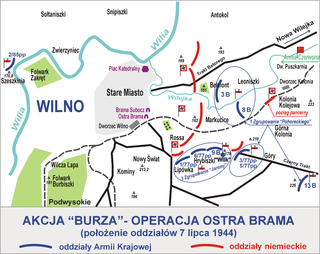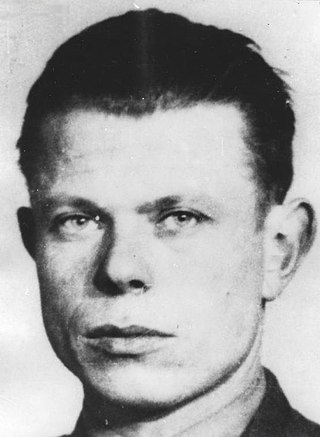
Drohiczyn is a town in Siemiatycze County, Podlaskie Voivodeship, Poland. The town has a population of 2,110 and is situated on the bank of the Bug River. Drohiczyn has a long and rich history, as in the past it was one of the most important cities of the region of Podlachia. Currently, it is the seat of Roman Catholic Diocese of Drohiczyn.

Ashmyany or Oshmyany is a town in Grodno Region, Belarus. It is located 50 kilometres (31 mi) from Vilnius in Lithuania, and serves as the administrative center of Ashmyany District. It lies in Ashmyanka's river basin. As of 2023, it has a population of 16,870.

27th Volhynian Infantry Division was a World War II Polish Armia Krajowa unit fighting in the Volhynia region in 1944. It was created on January 15, 1944, from smaller partisan self-defence units during the Volhynia massacre and was patterned after the prewar Polish 27th Infantry Division.

Operation Ostra Brama was the Polish Home Army's attempted takeover of Vilnius in wake of the German Wehrmacht's evacuation, ahead of the approaching Soviet Red Army's Vilnius offensive. A part of a Polish national uprising, Operation Tempest, the action happened on 7–13 July 1944.

Operation Tempest was a series of uprisings conducted during World War II against occupying German forces by the Polish Home Army, the dominant force in the Polish resistance.

The Belarusian resistance during World War II opposed Nazi Germany from 1941 until 1944. Belarus was one of the Soviet republics occupied during Operation Barbarossa. The term Belarusian partisans may refer to Soviet-formed irregular military groups fighting Germany, but has also been used to refer to the disparate independent groups who also fought as guerrillas at the time, including Jewish groups, Polish groups, and nationalist Belarusian forces opposed to Germany.

When the Second World War in Europe began, the territory which now forms the country of Belarus was divided between the Soviet Union and the Second Polish Republic. The borders of Soviet Belarus were greatly expanded in the Soviet invasion of Poland of 1939. In 1941, the country was occupied by Nazi Germany. Following the German military disasters at Stalingrad and Kursk, the collaborationist Belarusian Central Council (BCC) was formed by the Germans in order to raise local support for their anti-Soviet operations. The BCC in turn formed the twenty-thousand strong Belarusian Home Defence (BKA), active from 23 February 1944 to 28 April 1945. Assistance was offered by the local Soviet administrative governments, and prewar public organizations including the former Soviet Belarusian Youth. The country was soon retaken by the Red Army in 1944. Devastated by the war, Belarus lost significant populations and economic resources. Many battles occurred in Belarusian and neighbouring territory. Belarusians also participated in regional conflicts.

In Poland, the resistance movement during World War II was led by the Home Army. The Polish resistance is notable among others for disrupting German supply lines to the Eastern Front, and providing intelligence reports to the British intelligence agencies. It was a part of the Polish Underground State.

Maciej Kalenkiewicz was a Polish engineer and lieutenant colonel of the Polish Army. During World War II was a soldier of Henryk Dobrzański's military unit, member of cichociemni, officer of the Home Army, partisan commander in the Nowogródek District of the Home Army.
As a result of the Soviet invasion of Poland in 1939, hundreds of thousands of Polish soldiers became prisoners of war. Many of them were executed; 22,000 Polish military personnel and civilians perished in the Katyn massacre alone.
The Polish 4th Infantry Division was created following Polish independence after the end of World War I. The division participated in the Polish–Ukrainian War in 1919. During World War II, the division existed as three wholly separate organizations, the original incarnation of the division as part of the pre-war Polish Army, the second incarnation armed and equipped by the western Allies, and another division armed and equipped and controlled by the Soviet Union. The second and third incarnations of this division existed simultaneously from 1944 until 1947.
5th Legions Infantry Regiment of Józef Piłsudski was an infantry regiment of the Polish Army in 1918–1939. It was garrisoned in Vilnius as part of the 1st Legions Infantry Division.

8th Legions Infantry Regiment was an infantry regiment of the Polish Army. It existed from 1918 until 1939. Garrisoned in Lublin, and belonged to the 3rd Legions Infantry Division from Zamość. The regiment traced its traditions back to the 8th Infantry Regiment of the Duchy of Warsaw, commanded by Colonel Cyprian Godebski.

Stanisław Jerzy Sędziak, noms de guerre "Warta", "Wola", "Oset", "Wojna", "S-2", "T", "Stanisław Sędziszewski", "Zaremba", "Kulesza", "Czesław Noakowski" – a certified lieutenant colonel of the Polish Army, participant in the defensive war of Poland in 1939, cichociemny; 1942–1944 chief of staff of the Home Army Nowogródek District, in 1944 acting commander of the district, deputy and then chief of staff of the Białystok Citizens' Home Army District, Delegate of the Armed Forces for the Białystok District, in the years 1945–1947 deputy president of the WiN Central Area Management.

Surkanty is a village in Voranava District, Grodno Region, Belarus. It is part of Boltsishki selsoviet.

Stryyewka or Strievka is a village in Grodno District, Grodno Region, Belarus.
Mikulishki is a village in Ashmyany District, Grodno Region, Belarus. It is situated on the Merkys River.
Bobravichy is a village in Iwye District, Grodno Region, Belarus.
Dyndylishki is a village in Iwye District, Grodno Region, Belarus.
Pyeskawtsy is a village in Voranava District, Grodno Region, Belarus. It is part of Misyavichy selsoviet.












